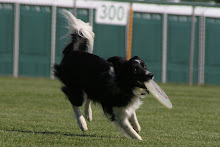I use NRMs from time to time. I know they can be controversial in positive dog training circles, but I find them useful to provide information to a dog and non-aversive. I don't use them in the training/shaping stage of teaching a behavior, but I do have various other uses for them. I usually use the word "oops" and it's not something I set out to train, the dogs just end up picking it up on their own eventually. I've never had a NRM for Jun and sometimes I've felt like it would be useful.
So, Jun sucked (past tense) at going to her mat. This was entirely my fault for not teaching it to her properly to begin with, but is also her fault for being manipulative and gradually training me to accept less and less. No, in fact, I am not smarter than my dog. At some point I realized that Jun was only going near her mat, or at the most, putting her back paws on it.
I wanted to change this so I went back to mat basics, re-shaping the behavior with more specific criteria--elbows on the mat. However, I ran into a problem. Exhibit A: Jun goes to the mat and lays down on it with her elbows off. What do I do? Since this behavior is already fully trained as a duration behavior if I just withhold the click she will keep laying there. I could release her, but her release cue has been heavily reinforced and giving her a release would act as a secondary reinforcer to a behavior I don't want to reinforce. So I can't let her lay there, but I can't give her another cue. What to do? Enter the no-reward marker. In an effort to make her get up but not really give her a release, I started doing a dismissive, swishy thing with my hand. It was successful in making her get up and I did not reward her getting up, so she went back to the mat and tried again. If she got her elbows on, I'd click and treat. If not, swishy-hand-thing. Eventually this (probably coupled with a look on my face that says "that's not right and you know it") has become a NRM. It turned out to be very effective to correct Jun's sloppy mat performance. She now gets elbows on probably 95% of the time. And she also generalized the NRM to other contexts where she likes to see how little she can do--like finishes. If she gives me less than I know she's capable of I give a NRM, re-cue, and she usually gets it right the second time.
It's worked for us. Would anybody have solved this problem a different way?
Subscribe to:
Post Comments (Atom)





I don't really try to analyze the terms for the training I do, so I have no idea if I use NRMs. I try and interrupt wrong responses if at all possible and reset the dog or make thier error bigger. I usually don't let a dog "fix" themselves if we're past that initial shaping phase.
ReplyDeleteSo say a sloppy front would get some type of verbal exclamation in a happy voice such as a "oh dude!" and me immediately moving side step in the direction to accentuate their error. Or for the mat example, if my dog didn't actually touch the mat or didn't lie down immediately, I do some exclamation and pull the dog back to try again from the same starting position. I wouldn't let the dog remain there and fix himself by moving more to it or downing.
I think it's great that you picked up a way to communicate more with Jun!